Mopani trees with their butterfly-shaped leaves and variable growth habits are beautiful to look at, and being hardy and nutritious too they support an abundance of life in hot, dry and low-lying areas, such as in the northern sections of Kruger National Park.
As mopane trees (Colophospermum mopane) occur only in the very north eastern parts of South Africa and in other southern African countries north of our borders, I am most familiar with them from trips to neighbouring Botswana. Mopane trees are associated with sandy, poorly drained soils and they also occur in alkaline and alluvial (floodplain) soils. Mopane trees cope with heat by folding their two-winged leaves together to conserve moisture – which by the way also reduces any shade that they might cast.
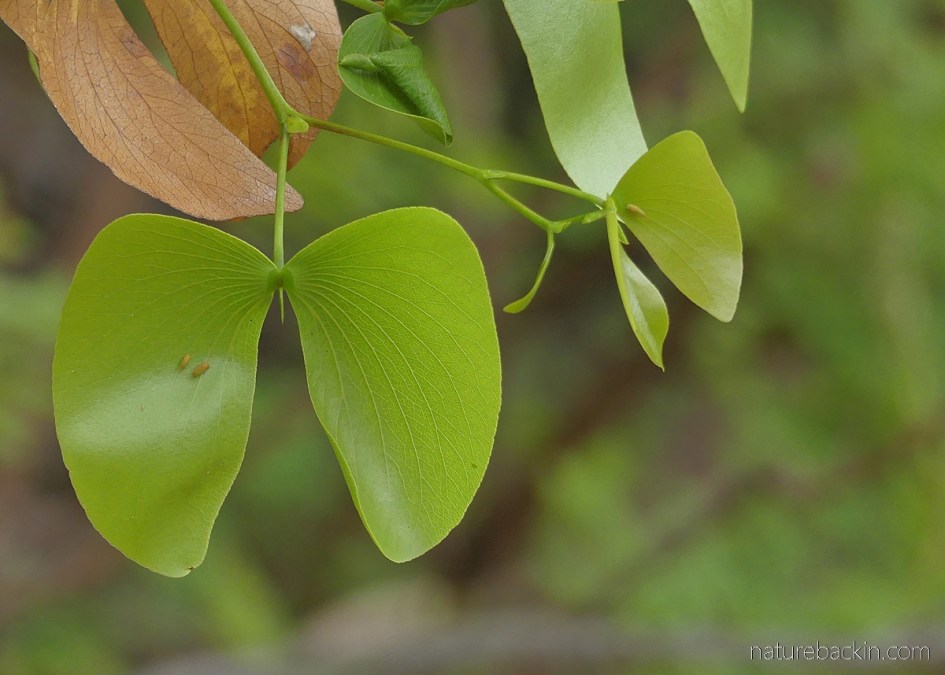
In the photo above, small insects are visible on the open butterfly-shaped leaves. I am wondering if they are mopane psyllids (Retroacizzia mopanei). In the winter months the nymphs of these small sap-sucking insects produce sweet-tasting honeydew on the mopane leaves that is edible to humans as well as to birds, baboons and monkeys.
Mopane trees are variable in size and form depending on soil conditions, rainfall patterns and the occurrence of fire. In their range in South Africa in the north eastern regions in Limpopo and Mpumalanga provinces mopane varies in size from scrub a few meters high to trees of about 18 metres. Mopani trees also occur more broadly in most southern African countries to the north of South Africa. In some regions, such as in Zimbabwe and in Botswana’s Okavango region, mopane trees commonly grow up to about 22 metres tall to form impressive woodlands that are known as cathedral mopane.
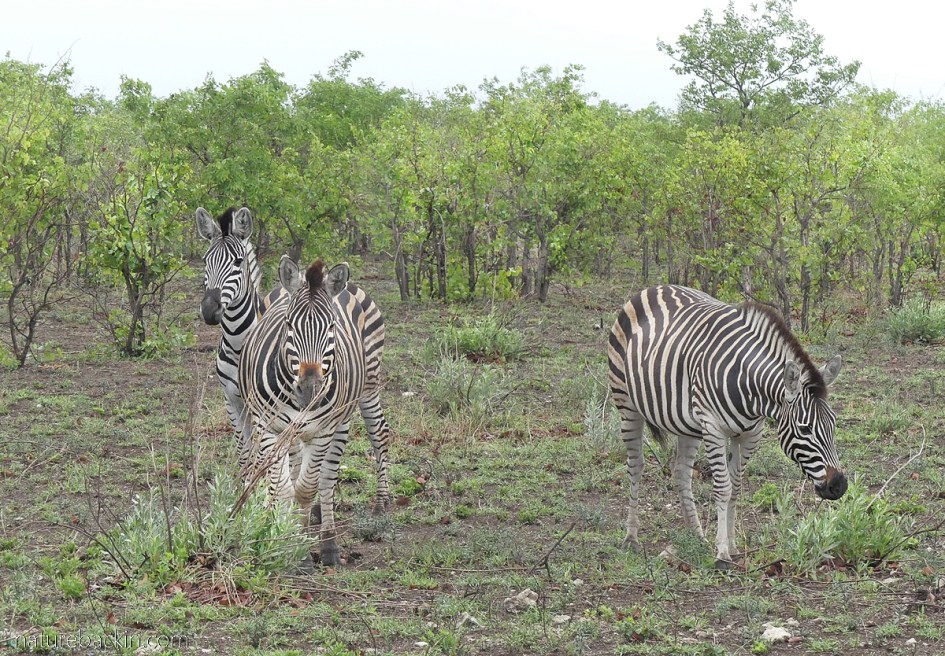
Scrubby mopane trees mostly about three metres high were sporting green leaves in a part of northern Kruger National Park that had had a bit of rain, as can be seen also by the grass that is just starting to green up, providing grazing for these zebras (Equus quagga burchelli).
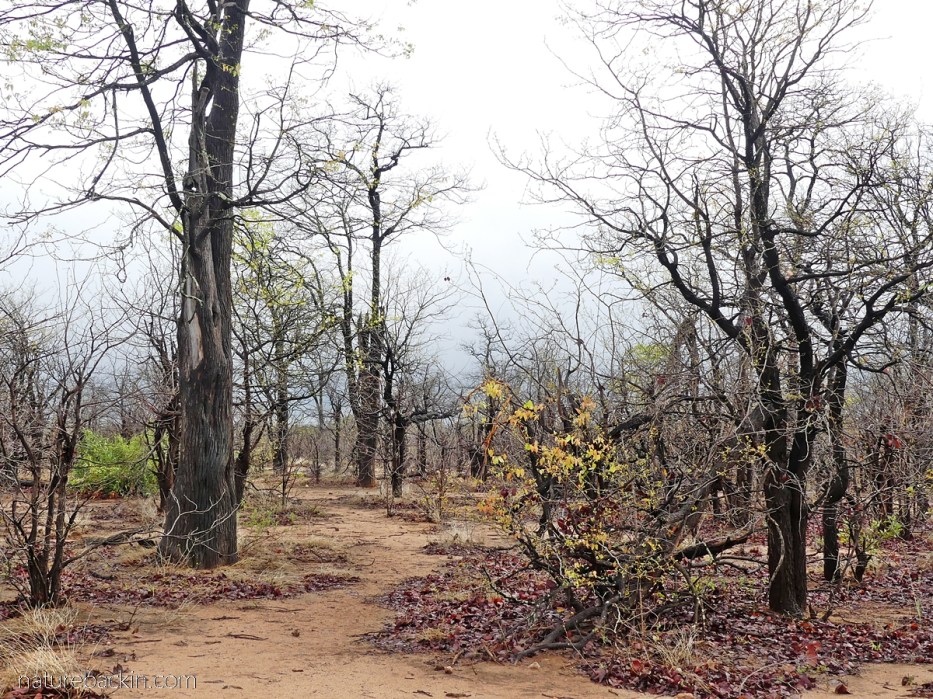
In another section of the park that had had less rain the mopane trees were only just starting to sprout new leaves. The new leaves are in beautiful colours of gold, lime and orange, colours usually associated with autumn rather than the first flush of leaves in early summer. In this area the mopane trees are taller, forming woodland where they are the dominant plant in the sandy soil that likely overlies clay.
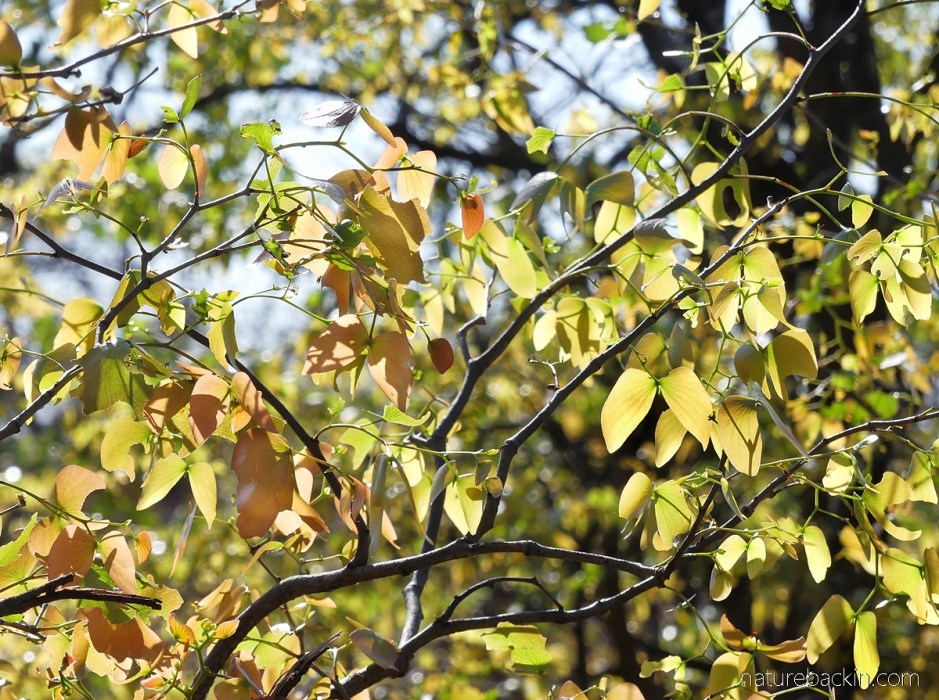
Above is a closer look at new mopane leaves backlit by morning sunshine.
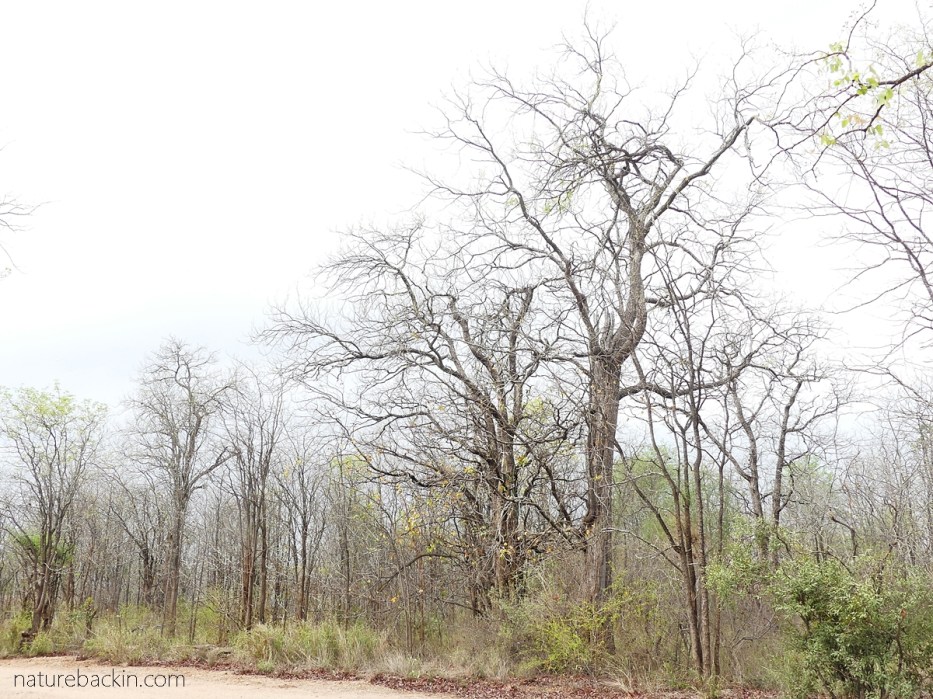
It is hard to believe that this woodland of large trees just coming into leaf are also mopane trees in the same season and region. This mopane woodland is at the Sirheni Bushveld Camp in Kruger National Park.
Across their range depending on conditions mopane are deciduous or semi deciduous. Mopane trees grow in arid regions with very little rainfall as well as in hot frost-free regions with summer rainfall. Losing their leaves in winter is more related to coping with dry conditions rather low cold temperatures as winters in the Lowveld are not very cold. Remaining bare is a mechanism for mopane trees to survive the dry winter months.
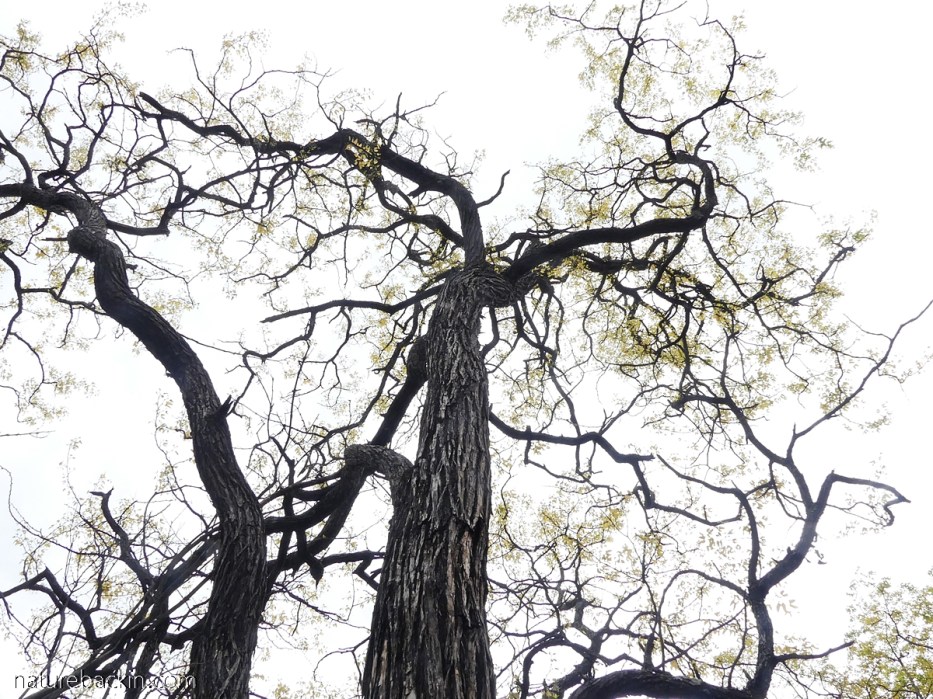
Looking up – a tall mopane tree at Sirheni Bushveld Camp was just starting to come into leaf. The textured bark is very distinctive.
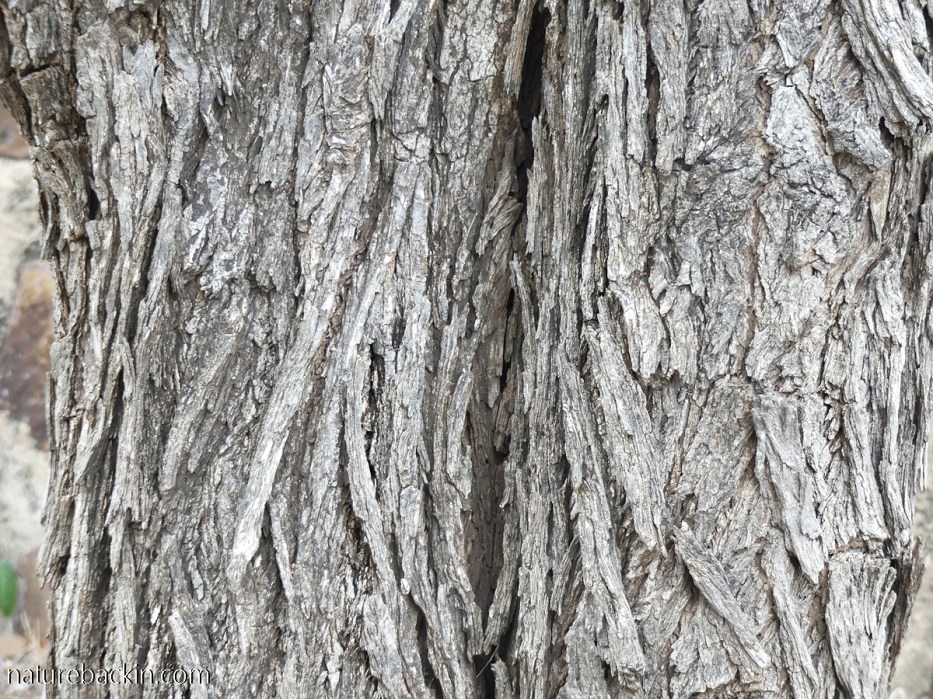
Above is a close-up shot of the almost ropey texture of the bark on the trunk of a mopane tree at Kruger National Park.
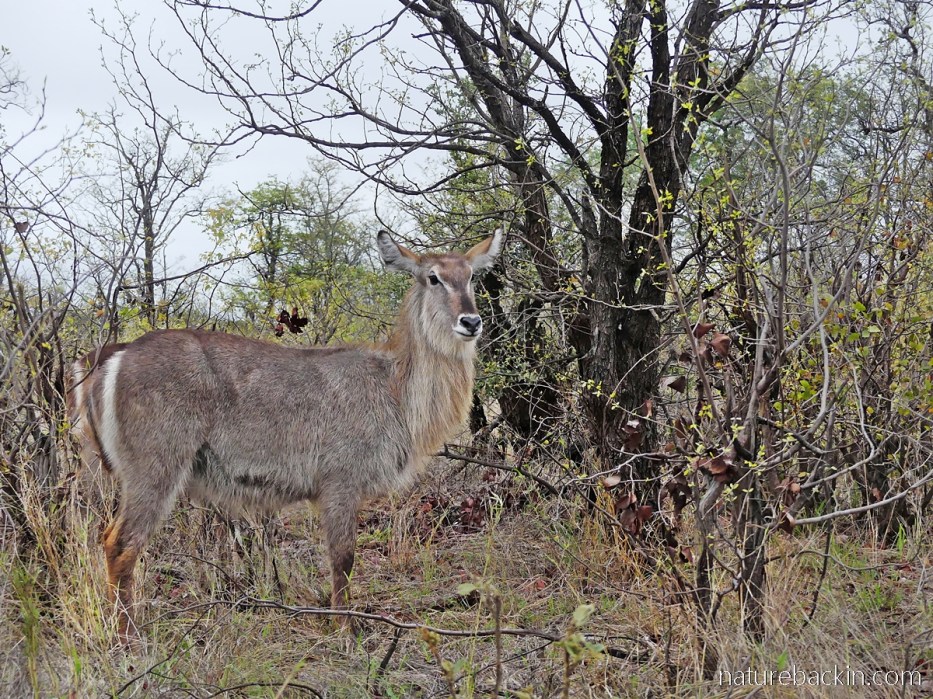
We came across a small group of waterbuck (Kobus ellipsiprymnus) in a dry section of the park where the mopane leaf buds were just starting to unfurl.
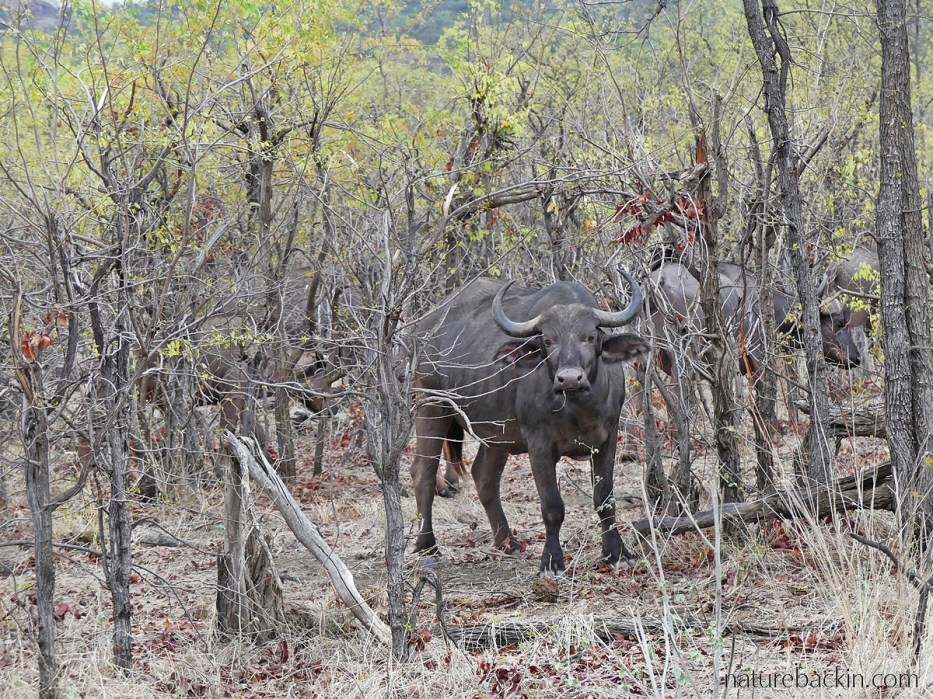
A herd of buffalo (Syncerus caffer caffer) were near the road and so easily visible in the mopane that was starting to leaf-up. When the mopane is in full leaf it is very difficult to spot animals through the dense foliage in mopane scrub, which is why the mopane scrub regions are not as popular with visitors to Kruger National Park as the more open regions in the central and southern regions of the park.
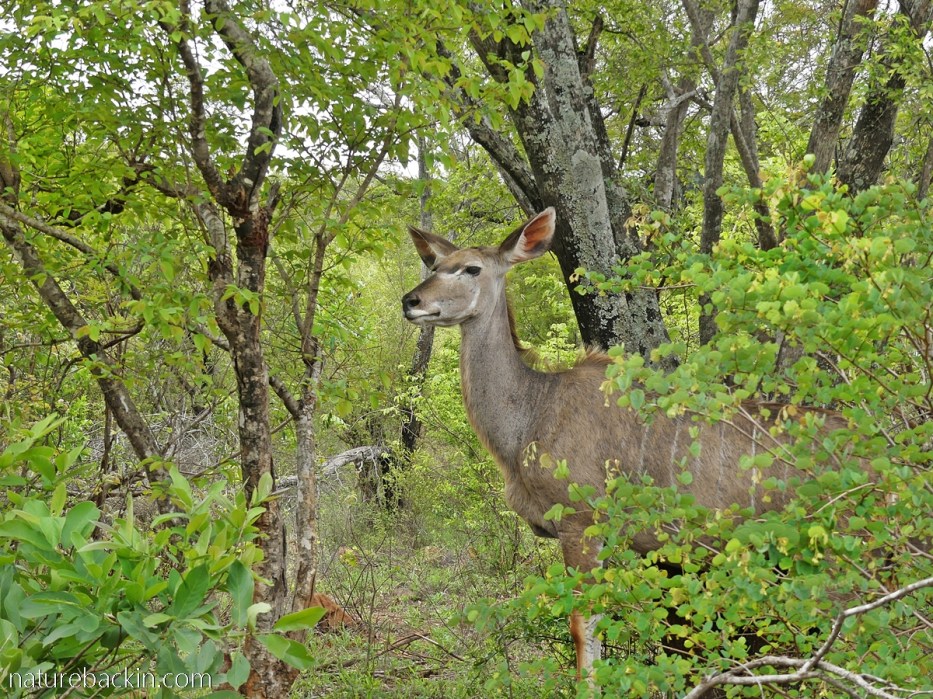
In a taller mixed woodland area the mopane was already almost in full leaf and sheltering a small group of kudu (Tragelaphus strepsiceros), one of which is in the photo above. Mopane leaves are nutritious for many browsing animals, with the young leaves being the most palatable.
Mopane trees are also known as turpentine trees as the leaves and the pods have a turpentine odour when crushed. However, even domestic stock can become accustomed to the odour and will eat either fresh leaves or dry leaves that have fallen to the ground.
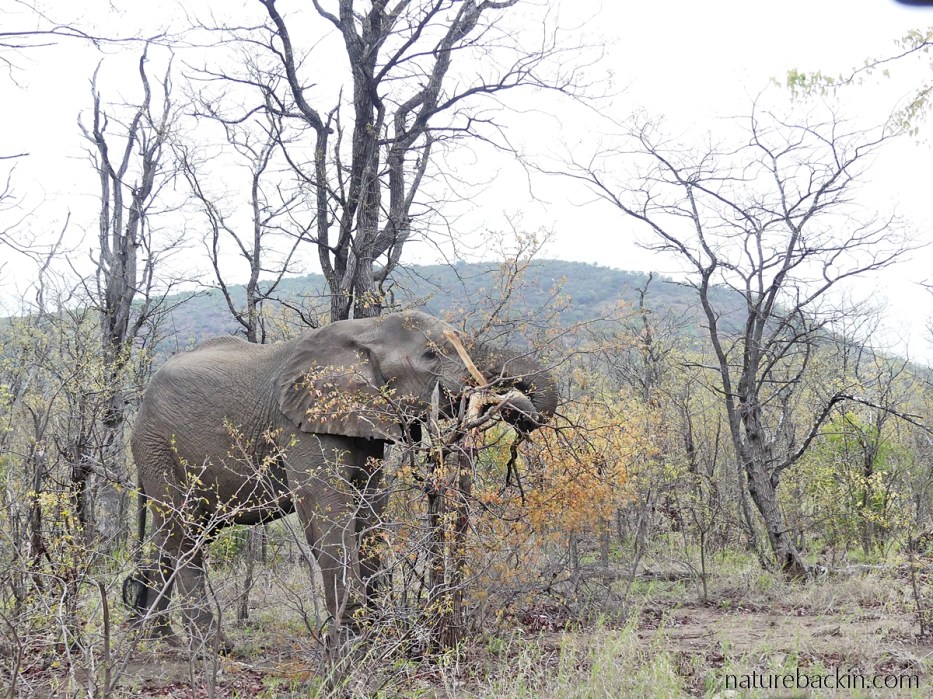
Elephants (Loxodonta Africana) not only browse the leaves but they also break mopane trees so that they can strip the nutritious bark. We watched this elephant break a small mopane tree and then systematically strip the bark using its dextrous trunk with the aid of its tusks and a well-placed foot to get the job done efficiently. The “pruning” practices of elephants effectively pollard the trees and have an effect on the density and height of the mopane scrub.
Mopane trees and bushes have the ability to release unpleasant-tasting tannins into the leaves while they are being heavily browed so that any browsing animals will move on. More amazing still is while being browsed not only do they release tannins into the leaves but they release pheromones into the air that warn neighbouring plants of the threat so that they too can defend themselves by releasing tannins.
As explained by tree expert Gus Le Breton, the pheromones are carried on the breeze to neighbouring plants, so such “messages” are carried downwind. He says that consequently elephants have worked out to browse in an upwind direction. You can see a short video of Le Breton explaining this phenomenon here.
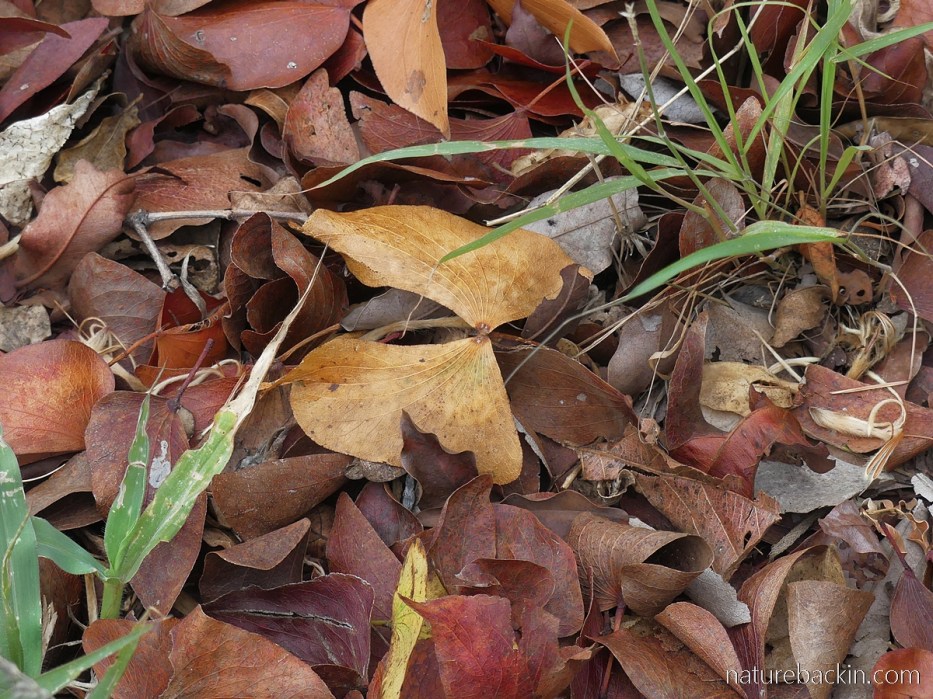
In late-November a thick carpet of dry leaves still remained in mopane woodland at Sirheni Bushveld Camp, providing habitat and food for many creatures.
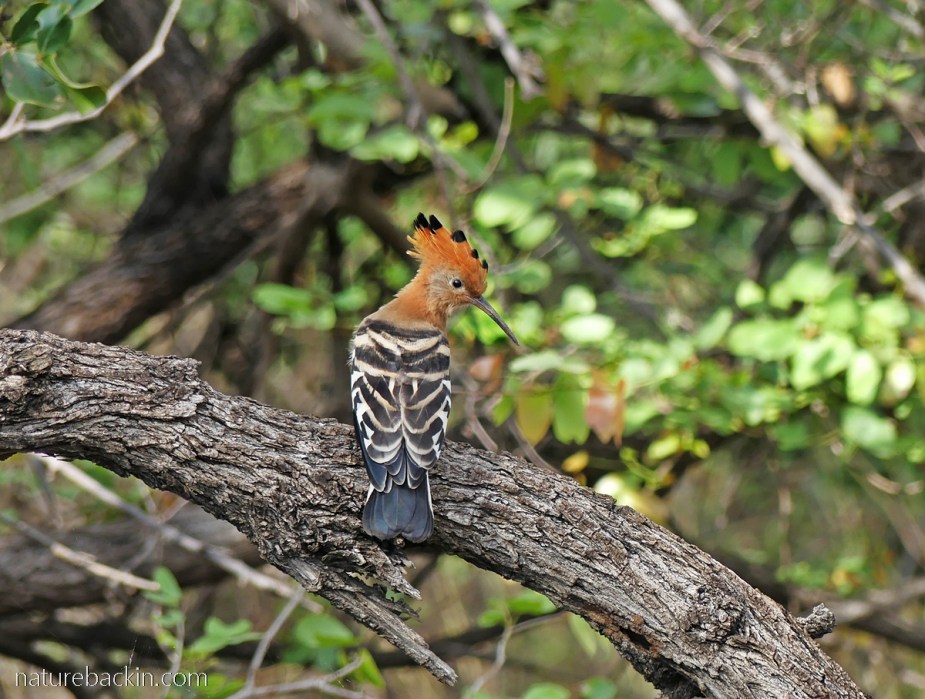
Of course we also saw many birds inhabiting the mopane scrub and woodlands, including this African hoopoe (Upupa Africana) that had just flown up into a mopane tree after foraging on the ground.
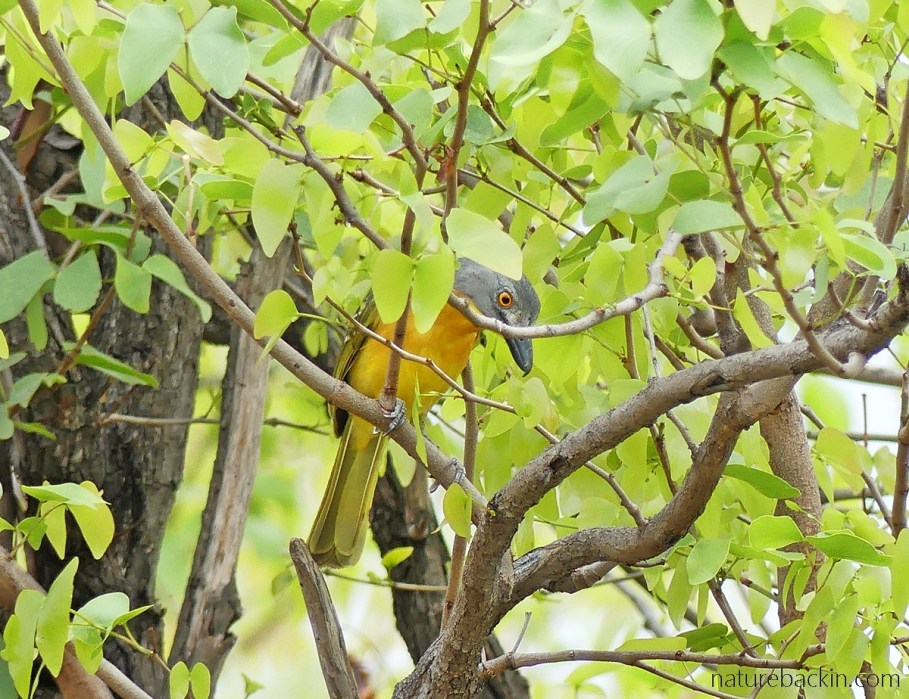
Only because we had stopped to look at something else did we hear a grey-headed bushshrike (Malaconotus blanchoti) uttering a loud clicking call (part of a larger repertoire) while it was partially concealed among green mopane leaves.
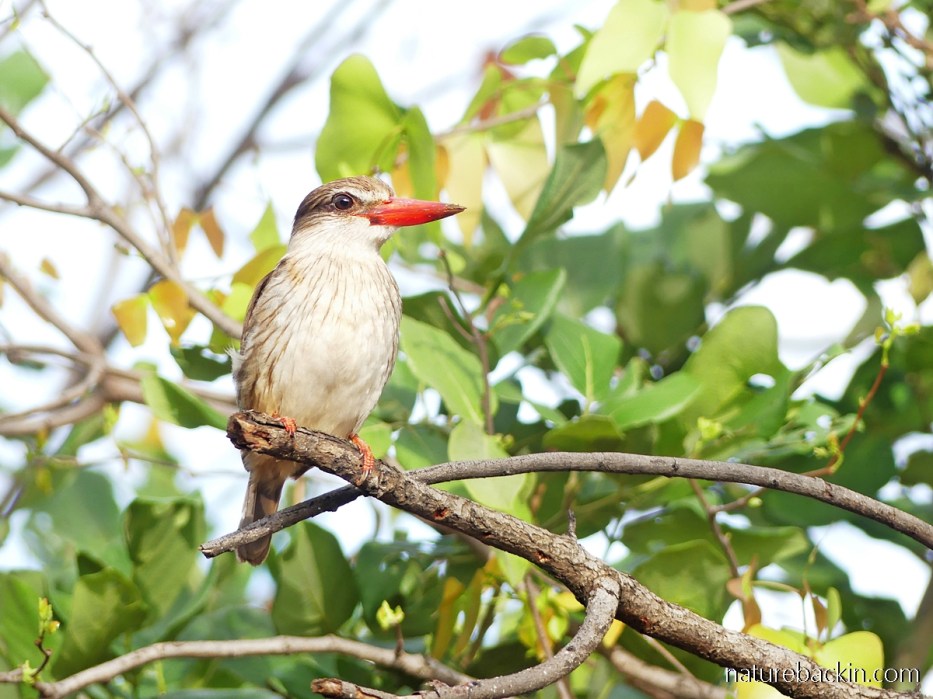
We saw this brown-hooded kingfisher (Halcyon albiventris) perching in mopane scrub in bright sunshine early one morning.
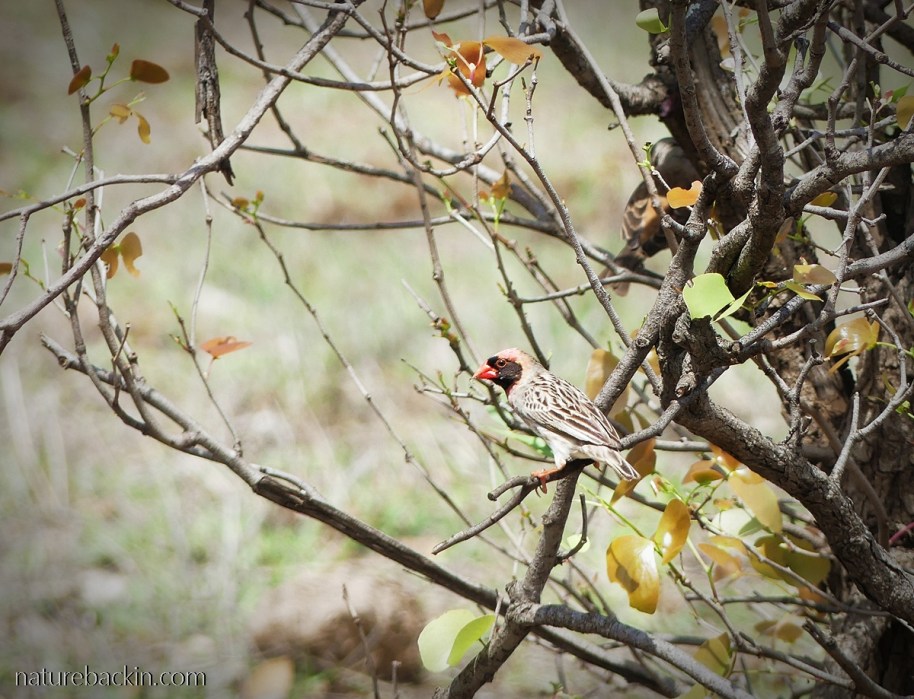
A red-billed quelea (Quelea quelea) was taking a break from looking for food on the ground by perching in a mopane that was starting to show its new colourful leaves.
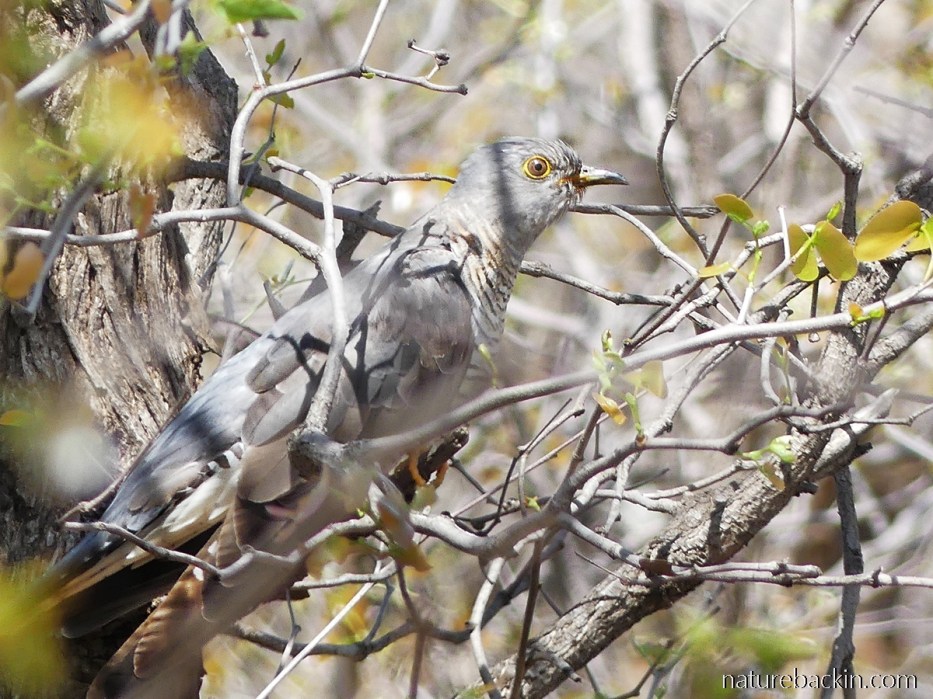
By chance we saw this bird flying off a short distance before it perched a metre or so from the ground in mopane scrub. At first with all the barring we thought it was a small raptor but then we realised it was a cuckoo. It could be either an African Cuckoo (Cuculus gularis), which is an intra-African breeding migrant, or a common cuckoo (Cuculus canorus), but it is hard to see which in this photo as the bird was partially obscured and in difficult light. The common cuckoo migrates from the Palaearctic regions where it breeds, but while it is escaping the northern winter, in the southern hemisphere it does not breed. It is a rare vagrant in South Africa. When in South Africa, perhaps because it is not breeding, it does not call so we never hear the legendary “cuck-oo” call in these parts.
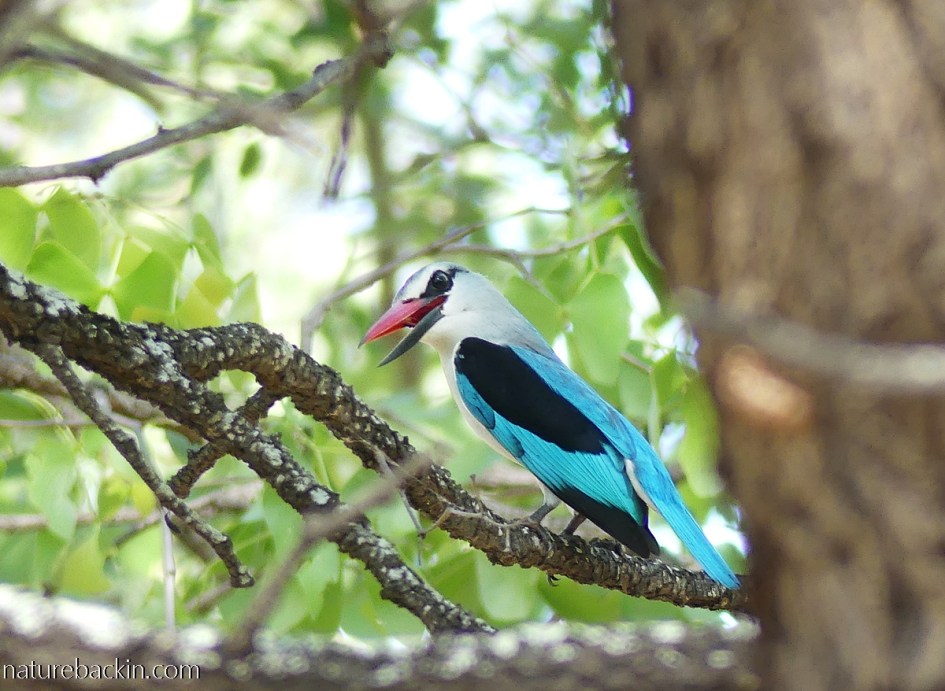
Despite its loud trilling call drawing attention to it, the exquisitely coloured woodland kingfisher (Halcyon senegalensis) proved frustratingly difficult to photograph. My husband managed to snap this photo of one perched in a mopane tree in the camp at Shimuweni Bushveld Camp.
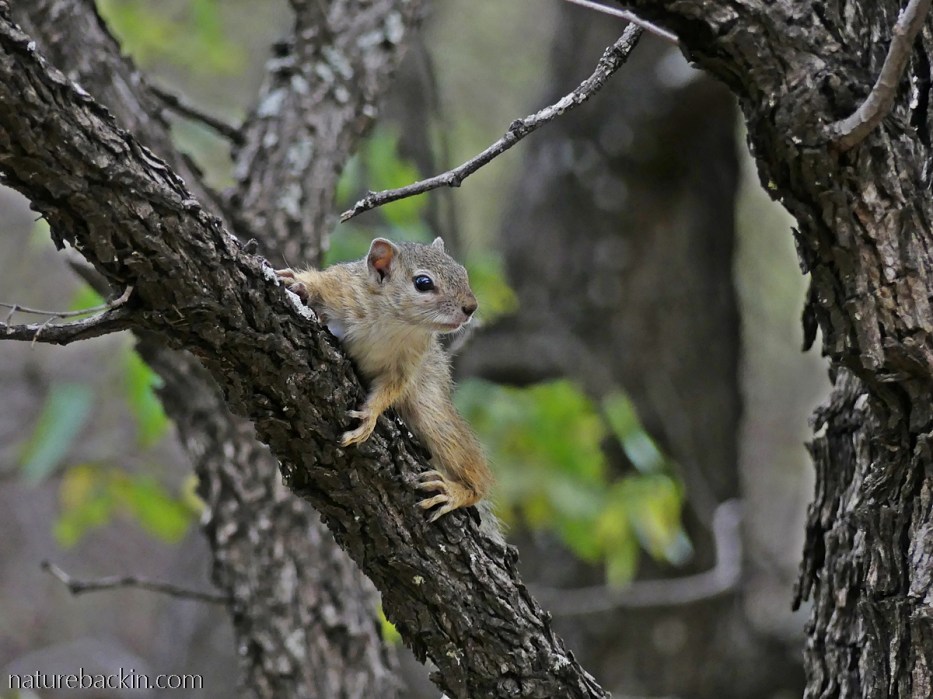
Not a bird, but also photographed perched in a mopane in the grounds of the Shimuweni Bushveld Camp, was this very alert tree squirrel (Paraxerus cepapi). In South Africa these small squirrels (weighing only about 200 grams) occur only in the most northerly regions. They are known to favour nesting in cavities in mopane trees.
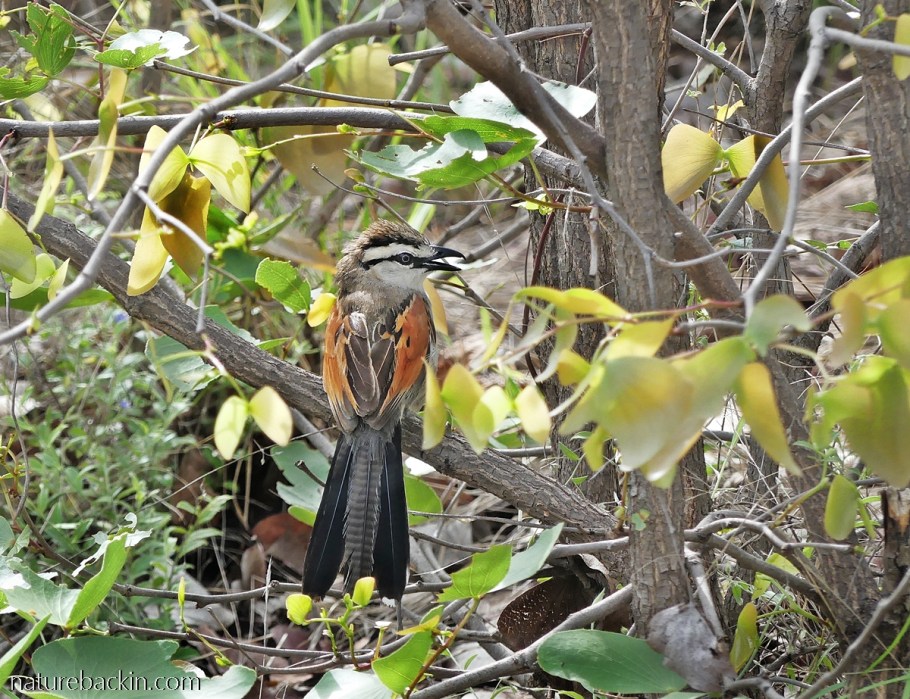
A brown-crowned Tchagra (Tchagra australis) probably hoping it has not been spotted as it seeks cover at the base of a scrubby mopane tree.
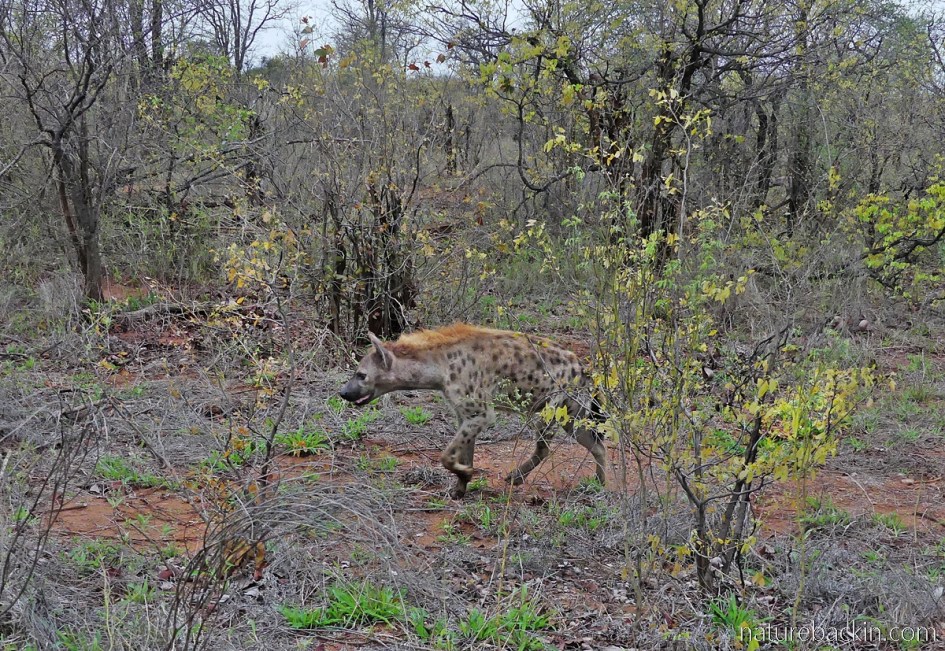
This spotted hyaena (Crocuta crocuta) was mooching along through mopane scrub next to the road early one morning. Two companions had already melted away into the shrubby cover. When we first saw them the three hyaenas had been walking along the tarred road, probably on their way back to the den after a night out.
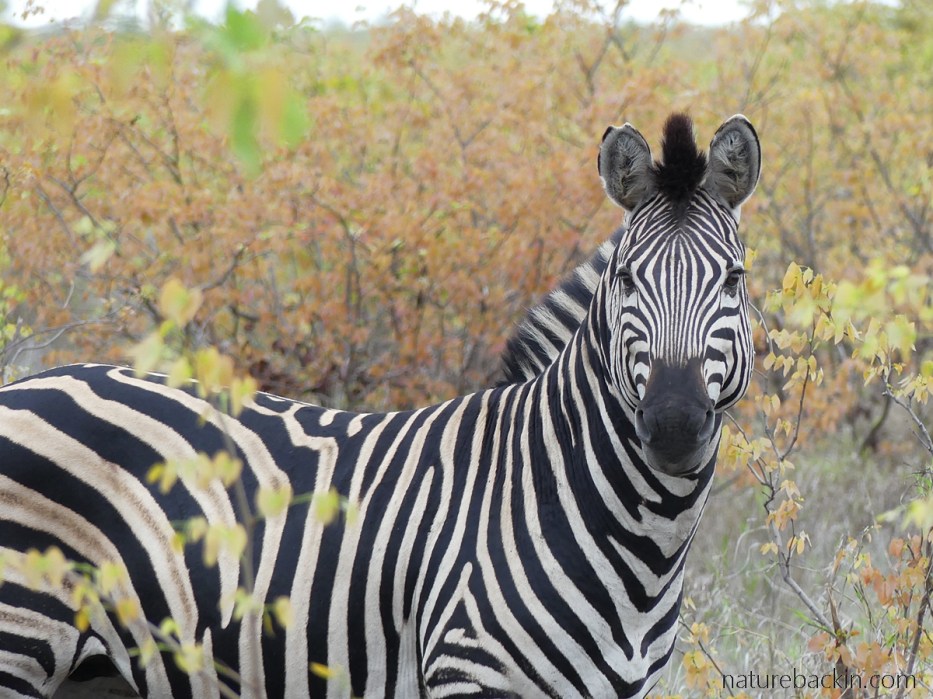
And to end this selection of mopane-related photos, the orange and gold hues of new mopane leaves provide a warm backdrop for this zebra that is showing considerable poise. All of these photographs were taken on our trip to Kruger National Park in November 2021.
Sources:
Alice Aubrey. 2004. Colophospermum mopane. http://pza.sanbi.org/colophospermum-mopane; Becking, David. [n.d.] Colophospermum mopane. Tree SA. https://treesa.org/colophospermum-mopane/; Chittenden, Hugh, Davies, Greg & Weiersbye, Ingrid. 2016. Roberts Bird Guide: Illustrating nearly 1,000 Species in Southern Africa (2nd edition). Cape Town: Jacana; Le Breton, Gus. [n.d.] Plant Communication – The Strange Case of the Elephant and the Mopane. https://wildmercury.org/plant-communication-the-strange-case-of-the-elephant-and-the-mopane/
Posted by Carol

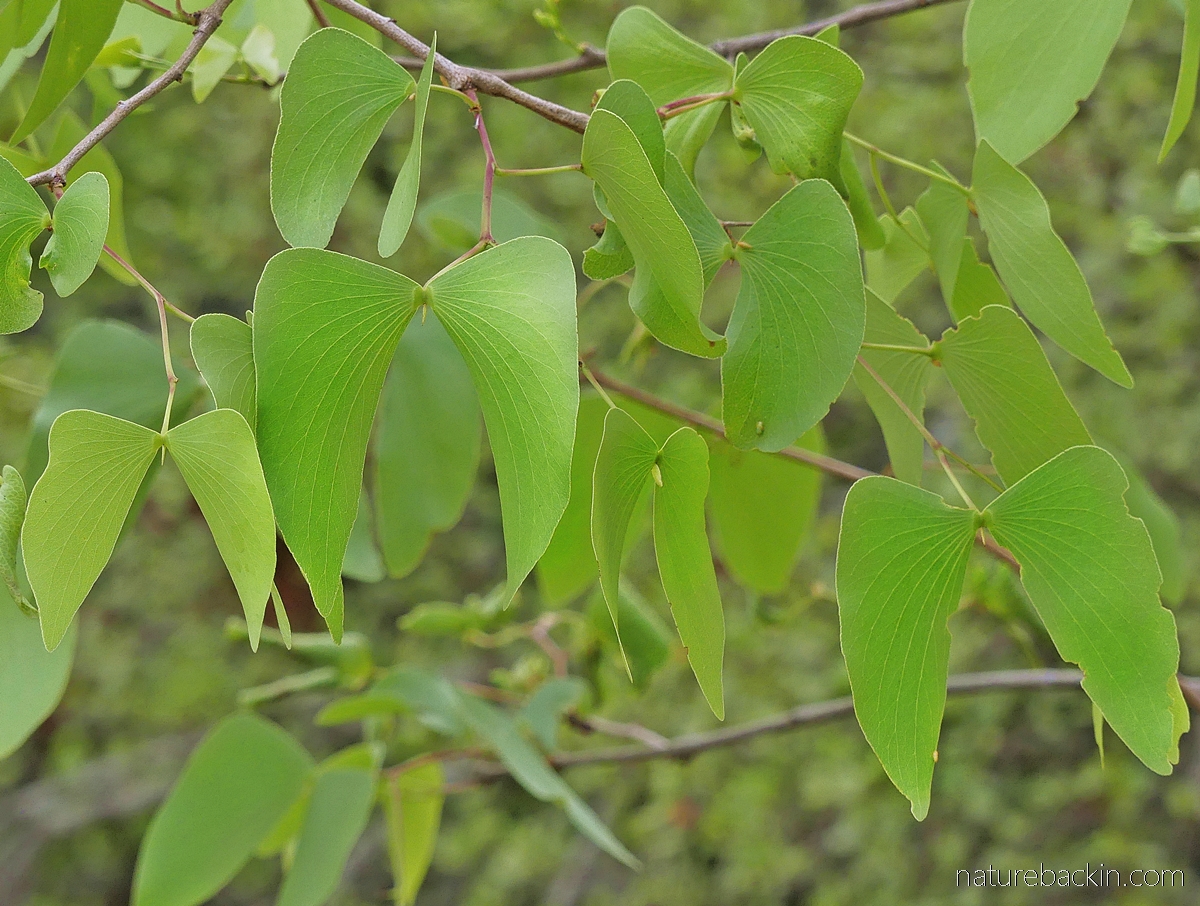







January 5, 2022 at 6:26 pm
Fabulous Carol! I have not visited the northern regions of the park but many of the birds and animals you show us here are those I have seen in the more popular southerly areas. Thank you for these stunning shots and for evoking some treasured memories 😊
And a belated Happy New Year! Hopefully a better one for all of us.
LikeLiked by 1 person
January 6, 2022 at 8:05 pm
Hi Sandra – nice to hear these KNP pics evoke special memories for you.
Thanks very much for the best wishes for the New Year, and wishing you the same and a better year ahead …
LikeLiked by 1 person
January 4, 2022 at 3:55 pm
This looks a slightly bleak and austere landscape. But the life within it is anything but!
LikeLiked by 1 person
January 5, 2022 at 2:10 pm
After a bit more rain it will be a lot less bleak and austere, but even when dry it is amazing the variety of life that abounds.
LikeLiked by 1 person
January 4, 2022 at 5:34 am
Because of their strong association with northern Kruger and my favourite place on earth, Shingwedzi, I really love mopane trees in all their forms. Amazing to through dense mopane to suddenly see any kind of animal emerge from the thickness into the road.
LikeLiked by 1 person
January 5, 2022 at 2:08 pm
Glad to hear that you also love mopane trees 🙂
LikeLike
December 31, 2021 at 2:53 am
I had never heard of a mopane tree–fascinating! And I never tire of your bird pics. We have kingfishers here, but not nearly as colorful! I chuckled as I saw the hoopoe: I only know it from an episode of this pretty goofy mystery show I watch (Midsummer Murders)! Nice to know it actually is a real bird.
Hope you are staying safe…and that you are on the downswing of the omicron. I am planning a “staycation” as the tough month is just beginning .
Regards,
Julie
LikeLiked by 1 person
January 1, 2022 at 1:28 pm
I just read a synopsis of the Midsomer Murders rare hoopoe episode (never having watched it) – it seems to be hilariously complicated!
Re the hoopoe, some years back we were in Athens (at the Temple of Zeus) and much to our amazement we saw a hoopoe. We subsequently learnt that there is also a Eurasian hoopoe, slightly different to the species found in the southern half of Africa.
Omicron seems to be on a downswing here in SA but we are waiting to see what happens after the festive period and associated gatherings, so its a staycation time for us too currently. Sorry to read of such burgeoning infection rates in the US, Europe and elsewhere.
Sending best wishes during these ongoing tough times.
LikeLiked by 1 person
December 21, 2021 at 4:37 am
Lovely post Aunty Carol.
So pleased you had an awesome trip.
What amazing trees, these mopane trees. Wow, they actually talk to each other. 🤯
Have a blessed Christmas. Much love
LikeLiked by 1 person
December 22, 2021 at 9:06 pm
Thank so much Debbie. The mopane trees are quite magical.
Best for a happy Christmas to you too
xxx
LikeLike
December 20, 2021 at 10:57 pm
Ahhh… such an amazing and exotic (to me) collection of creatures you found and shared. The only one I found to be fairly similar to our feisty little chipmunks was your tree squirrel! I enjoyed seeing all the variety… particularly the wonderful and colorful birds. Funny how your kingfisher (far more gorgeously colorful) is equally as elusive as our more sedate (colorwise) version.
It’s wonderful that you had such a pleasant opportunity to visit this amazing National Park.
Wishing you a happy and healthy holiday season. We intend to stay hunkered down for the duration.
LikeLiked by 1 person
December 22, 2021 at 9:05 pm
Thanks Gunta – it was nice to share some of the treasures of the mopane areas. We managed to time our trip between the fairly well-defined third wave of Covid infections and the predicted fourth wave. However, the arrival of the new fast-spreading variant has been a bit of a shock. We are back to being as reclusive as possible.
Wishing you all the best too as you hunker down over the holiday season.
LikeLike
December 22, 2021 at 10:24 pm
Brilliant timing actually. We live in an area with a lot of the crazy end of the population (the anti-vaxxers and those who are nasty about mask wearing). So it has seemed best to stay hunkered down right from the beginning. We did manage to squeeze in that visit with the grandkids during a time before Delta and shortly after we had our (then) completed vaccines. I feel a mix of relief and guilt that we are lucky enough to have access to vaccines and have the option to avoid most extraneous contacts. It’s quite disturbing to think of any who are not so blessed.
LikeLiked by 1 person
December 23, 2021 at 7:55 pm
Hears hoping before too long it will be possible to see your grandkids again. In the meantime it is a relief (and a privilege) to be able to be as reclusive possible. We will be eligible for our booster shots in January.
LikeLike
December 23, 2021 at 11:06 pm
It makes me feel a bit guilty to say we had ours perhaps a month ago? Sometimes it feels as though there isn’t much hope for the human species. How could we be fighting all this anti-vax stuff when it could alleviate so much suffering. On the other cynical hand… perhaps it’s just mother nature’s plan for shaking off this invasive human species. 🤯
LikeLiked by 1 person
December 27, 2021 at 7:27 pm
I am glad you had your booster shots. Here they are still maintaining a six-month interval for the Pfizer shots, but I think it is under review.
I find all those bigger questions exhausting …
LikeLike
December 20, 2021 at 4:23 am
I learned so much from your interesting post. Mopane trees look and sound fascinating–from starting out with autumn-colored leaves that turn green as they age, to folding their two-winged leaves like a butterfly, to releasing pheromones to alert their neighbors. I also loved all your animal photos, including all the gorgeous birds. Thank you for sharing.
Best wishes,
Tanja
LikeLiked by 1 person
December 22, 2021 at 8:39 pm
Thanks so much Tanja. And very best wishes to you too.
LikeLiked by 1 person
December 23, 2021 at 12:08 am
Thank you.
LikeLike
December 23, 2021 at 8:02 pm
Thanks Anne – sending best wishes for Christmas to you and yours.
LikeLike
December 19, 2021 at 9:22 pm
Fabulous collection of photos. It looks like you had a lovely time. That hyena looks rather preoccupied!
LikeLiked by 1 person
December 22, 2021 at 8:37 pm
Thanks Adele. It was a lovely break. The hyaena and pals appeared to be on a mission to get back to the den.
LikeLiked by 1 person
December 19, 2021 at 5:21 pm
What a wonderful post. Thank you
LikeLiked by 1 person
December 19, 2021 at 8:37 pm
Thanks very much Mariss. I hope you are having a peaceful holiday break.
LikeLike
December 20, 2021 at 6:12 pm
We are happily ensconced at Hogsback
LikeLiked by 1 person
December 22, 2021 at 8:39 pm
What a lovely place to spend Christmas and sending best Christmas wishes.
LikeLike
December 22, 2021 at 9:14 pm
A happy Christmas to you too Carol.
LikeLiked by 1 person
December 18, 2021 at 4:22 pm
Your birds are so colourful! Most of ours in Canada seem pretty bland in comparison.
LikeLiked by 1 person
December 19, 2021 at 8:39 pm
We are fortunate to have so many colourful birds, but I also like the delicacy of the more subtle colours too 🙂
LikeLiked by 1 person
December 18, 2021 at 5:00 am
Absolutely beautiful observation and photographs of Mopane trees and their associated inhabitants, thank you Carol! xxx
LikeLiked by 1 person
December 18, 2021 at 2:40 pm
Thanks Christeen. And to think that mopane scrub and woodland is written off by some as boring!
xxx
LikeLiked by 1 person
December 18, 2021 at 4:40 am
Fascinating post. Very informative and wonderful photos as always. I was amazed by the fact that the trees give off a warning to other trees and also the elephants’ response to this. Nature is truly amazing.
LikeLiked by 1 person
December 18, 2021 at 2:34 pm
Thanks Graham. Yes that info about the trees communicating is almost incredible. There is so much going on that we are completely unaware of!
LikeLiked by 1 person
December 18, 2021 at 3:54 am
Gosh Carol, you have some lovely photos from your trip to Kruger! I learnt a lot about Mopane from your post today. I love the photo of the little alert squirrel!
LikeLiked by 1 person
December 18, 2021 at 2:29 pm
Thanks Megan. Mopane is a really fascinating plant. Those squirrels seem to be almost constantly on high alert, twitching about most of the time and hardly still for an instant.
LikeLiked by 1 person
December 17, 2021 at 5:12 pm
A wonderful post, Carol. Informative, with excellent photos, I enjoyed learning about these beautiful trees. Their leaves remind me gingkoes, and while it has no other family members, perhaps mopane have a similar ancient lineage.
LikeLiked by 1 person
December 17, 2021 at 7:53 pm
Thanks Eliza – I can see why the mopane leaves made you think of the gingko. Although the mopane are the only species in the genus, they are not out on a limb on their own but are situated in the legume family (Fabaceae). It would be interesting to find out more about their lineage and evolution. They are very interesting – I did not have the space to mention some of the uses of mopane, for example medicinal uses, and their amazingly hard and termite resistant wood …
LikeLiked by 1 person
December 17, 2021 at 3:48 pm
What a splendid tour, Carol!
LikeLiked by 1 person
December 17, 2021 at 7:47 pm
Thanks very much Anne. I enjoyed highlighting the amazing mopane and some of the animals and birds we saw in the region.
LikeLike
December 17, 2021 at 1:13 pm
Such exquisite beauty! Thank you for sharing, and wishing you and all your dear ones a safe and happy holiday season 🙂
LikeLiked by 1 person
December 17, 2021 at 7:45 pm
Thanks Takami – there is such a remarkable diversity of life in the mopane areas.
Thanks for your good wishes for the holiday season that is somewhat constrained as the new Covid variant is leading to high infection levels. It seems wise once again to be as reclusive as is practical. Sending you and your family best wishes too for a safe and happy holiday season. It is incredible that the end of another stressful year is already here!
LikeLiked by 1 person
December 17, 2021 at 10:47 am
What a lovely adventure! Such glorious photos – had no idea how beautiful Mopane leaves were.
LikeLiked by 1 person
December 17, 2021 at 7:40 pm
It was an enjoyable trip, thanks Nikki. This is the first time I have seen mopanes so early in the summer and I was surprised at the amazing colours of the new leaves.
LikeLike